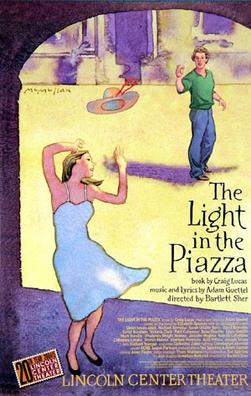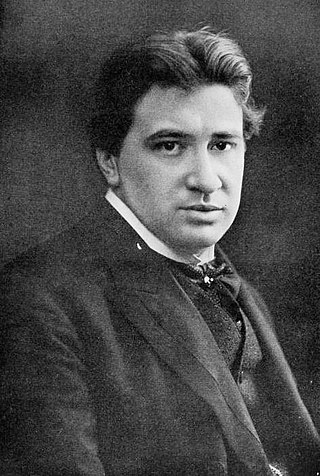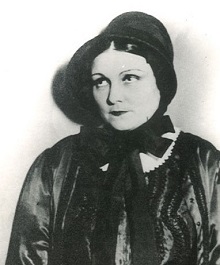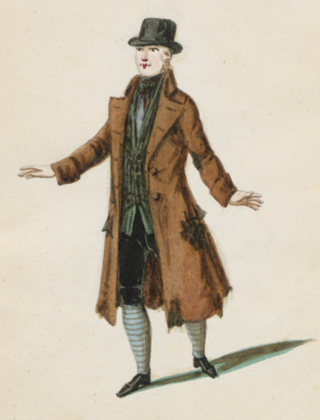
La sonnambula is an opera semiseria in two acts, with music in the bel canto tradition by Vincenzo Bellini set to an Italian libretto by Felice Romani, based on a scenario for a ballet-pantomime written by Eugène Scribe and choreographed by Jean-Pierre Aumer called La somnambule, ou L'arrivée d'un nouveau seigneur. The ballet had premiered in Paris in September 1827 at the height of a fashion for stage works incorporating somnambulism.

The Bridge of San Luis Rey is American author Thornton Wilder's second novel. It was first published in 1927 to worldwide acclaim. The novel won the Pulitzer Prize in 1928, and was the best-selling work of fiction that year.

La gazza ladra is a melodramma or opera semiseria in two acts by Gioachino Rossini, with a libretto by Giovanni Gherardini based on La pie voleuse by Théodore Baudouin d'Aubigny and Louis-Charles Caigniez. The Thieving Magpie is best known for the overture, which is musically notable for its use of snare drums. This memorable section in Rossini's overture evokes the image of the opera's main subject: a devilishly clever, thieving magpie.

Il turco in Italia is an opera buffa in two acts by Gioachino Rossini. The Italian-language libretto was written by Felice Romani. It was a re-working of a libretto by Caterino Mazzolà set as an opera by the German composer Franz Seydelmann in 1788.

The Light in the Piazza is a musical with music and lyrics by Adam Guettel, and a book by Craig Lucas.

Ivan the Fool, composed in 1913 by César Cui, is an opera-fairytale made for children in three tableaux. The libretto was written by Nadezhda Nikolaevna Dolomanova using Russian folk tales.

The Power of the Fiend is an opera in five acts by Alexander Serov, composed during 1867-1871. The libretto is derived from a drama by Alexander Ostrovsky from 1854 entitled Live Not As You Would Like To, But As God Commands. The opera was premiered posthumously on 19 April 1871 at the Mariinsky Theatre in Saint Petersburg conducted by Eduard Nápravník. Among the performers were Darya Leonova as Spiridonovna and Mikhail Sariotti as Yeryomka. Although in many ways it is more far-reaching than Serov's previous two operas, this work was not a success.
The Ballad of Baby Doe is an opera by the American composer Douglas Moore that uses an English-language libretto by John Latouche. It is Moore's most famous opera and one of the few American operas to be in the standard repertory. Especially famous are the title heroine's five arias: "Letter Aria," "Willow Song," "I Knew it Was Wrong", "Gold is a Fine Thing", and "Always Through the Changing." Horace Tabor's "Warm as the Autumn Light" is also frequently heard. Distinguished sopranos who have portrayed Baby Doe include Beverly Sills, Ruth Welting, Karan Armstrong, Faith Esham, and Elizabeth Futral.

Maometto II is an 1820 opera in two acts by Gioachino Rossini to an Italian libretto by Cesare della Valle. Set in the 1470s during a time of war between the Turks and Venetians, the work was commissioned by the Teatro di San Carlo in Naples. Della Valle based his libretto on his earlier play Anna Erizo. The name of the title character, Maometto II, refers to the real-life Ottoman Sultan and conqueror of Constantinople Mehmed II, who lived from 1432 to 1481.
Sir John in Love is an opera in four acts by the English composer Ralph Vaughan Williams. The libretto, by the composer himself, is based on Shakespeare's The Merry Wives of Windsor and supplemented with texts by Philip Sidney, Thomas Middleton, Ben Jonson, and Beaumont and Fletcher. The music deploys English folk tunes, including "Greensleeves". Originally titled The Fat Knight, the opera premiered at the Parry Opera Theatre, Royal College of Music, London, on 21 March 1929. Its first professional performance was on 9 April 1946 at Sadler's Wells Theatre.

Mese mariano is an opera in one act by Umberto Giordano. Its Italian libretto by Salvatore Di Giacomo was adapted from his play 'O Mese Mariano, which was in turn adapted from his novella, Senza vederlo. It premiered at the Teatro Massimo in Palermo on 17 March 1910. The opera is described as a bozzetto lirico and has a running time of 35 minutes. It tells the story of a woman who visits an orphanage to see her child. Racked with guilt at having abandoned him, she is unaware that he had died the night before.

Mariella Adani is an Italian classical soprano who had an active career in operas, concerts, and recitals from the 1950s through the 1980s. She has sung under the musical direction of Vittorio Gui, Carlo Maria Giulini, Nino Sanzogno, Oliviero De Fabritiis, and Peter Maag and under the directors Sandro Bolchi, Franco Zeffirelli Luchino Visconti, and Walter Felsenstein. A light lyric soprano, she has particularly excelled in the operas of Wolfgang Amadeus Mozart and Gioachino Rossini. She has also been admired for her performances in Baroque opera. Retired from the stage, she now devotes her time to teaching singing.

Cavalleria rusticana is an opera in one act by Pietro Mascagni to an Italian libretto by Giovanni Targioni-Tozzetti and Guido Menasci, adapted from an 1880 short story of the same name and subsequent play by Giovanni Verga. Considered one of the classic verismo operas, it premiered on 17 May 1890 at the Teatro Costanzi in Rome. Since 1893, it has often been performed in a so-called Cav/Pag double-bill with Pagliacci by Ruggero Leoncavallo.

La vedova scaltra is an updated opera-buffa in three acts by Ermanno Wolf-Ferrari to a text by Mario Ghisalberti, after Carlo Goldoni's original play first given in 1748.

Simone Berthe Ballard was a French operatic mezzo-soprano and contralto who sang leading parts, including premieres, at La Monnaie in Brussels.

Don Checco is an opera in two acts composed by Nicola De Giosa to a libretto by Almerindo Spadetta. It premiered on 11 July 1850 at the Teatro Nuovo in Naples. Don Checco was De Giosa's masterpiece and one of the last great successes in the history of Neapolitan opera buffa.

Fausta Labia was an Italian operatic soprano who was active mainly from 1892 to 1908. She made her debut in Naples in April 1892 as Valentine in Meyerbeer's Les Huguenots. After engagements at the Royal Swedish Opera in Stockholm (1893–95) and Lisbon (1896), she returned to Italy where she performed first in Turin, Rome and Bologna. Thereafter notable performances included the title role in Mascagni's Iris at La Fenice in Venice (1900) and Sieglinde in Wagner's Die Walküre at Milan's La Scala (1901).

Jolanda Meneguzzer was an Italian lyric soprano who made regular appearances at leading opera houses in the 1960s.
















